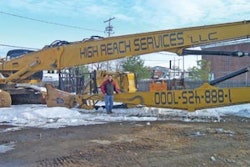I equate the running of a contracting business to the flying of an F-16 jet fighter through the Grand Canyon. You drop into the canyon at Point A, which is January 2 of any business year. You fly 300 feet above the canyon floor with the walls of the canyon 1,000 feet off each wing. You have to fly in a perfect straight line to Point B, which is December 31st of any business year. You want to arrive with a profit – preferably a hefty one.
On the floorboard of your plane are two pedals. You must keep the pedals even with each other. If one pedal gets out of line, the plane will begin to "yaw" and turn into one of the canyon walls. "So, what are these two pedals in the jet fighter called my business?" you ask.
One is the amount of overhead you must recover in a business year. The other pedal is the amount of business you must do in a business year to have enough money to recover that overhead, and to make a profit besides. Let's say that your overhead is $100,000. You have determined that you must do $400,000 in sales to recover that overhead and make a profit. You drop into the canyon on January 2, but by May 15 you see that you are behind your sales goal and you are not going to do $400,000 in sales. You will be lucky to do $350,000. Your pedals are now out of line. What is your plane doing? It is yawing. And, if it continues to yaw, you will crash your business into one of the walls of the Grand Canyon.
Now, if you were really in the Grand Canyon and your F-16 plane began to yaw, what would you do in a hurry? You would either push the left pedal forward or let off the right pedal until the pedals line up perfectly. So do the same with your business: Push the sales pedal forward, or let up on the overhead pedal.
Overhead is a fixed cost. It does not rise and fall based on what you charge for a certain job. You do not need to find out what others charge for overhead and charge the same. Overhead is not charged, it is recovered. And you don't make any profit until you recover your overhead. To do this you must budget overhead, spend overhead within that budget, allocate overhead properly, and recover it.
I know a company that has an accountant who is very nice, except on January 2. That day she comes in half an hour before everyone else and, with a wicked grin on her face, she turns on her computer and puts an invoice into the printer. She prints out a bill to management for the amount of overhead they must recover in that business year, and leaves a copy on each person's desk.
When the staff comes in reeling from New Year's festivities and football, they are faced with that invoice. They realize quickly that their plane has taken off and is descending into the Grand Canyon. They know they'd better keep their pedals even so they can arrive safely at the other end of the canyon on December 31 of the new year – with a profit. The staff knows where they stand, and that they had better go out that year and get enough work with enough overhead allocated on it to recover that overhead and make a profit.
I recommend that you keep track of the number of overhead dollars you must recover in a year on a computer spreadsheet program or on a piece of paper. Every time you sign a contract for a new job, subtract the amount of overhead you have built into that bid from the year's total. Make sure that within a business year you do enough work to bring the overhead dollars figure down to zero.
The staff of the construction company with the good accountant does not even talk about profit from January through mid-November because they consider that there is none. Any money collected above what it costs to do a job goes to pay overhead. The accountant keeps track and when the overhead is recovered she puts a copy of the original invoice on everyone's desk stamped "PAID IN FULL." At that point, they have a party. A Break-even Party. Right after the party they put the pedal to the metal because everything else they collect over costs for the rest of the year will be the company's profit.
Here is a point you must understand: You can make money on every job you perform but still lose money as a contractor. Some contractors don't understand what job costing really is. Job costing takes the original estimate of costs to do a job and compares it with the actual costs to do the job. This is done at the level of costs – that's why it's called job costing. Some contractors take job costing to another level. They add overhead to costs and subtract costs with overhead from the contract amount to see if they have made a profit. That is no longer job costing, it is generating a financial statement or a profit-and-loss statement on each job.
Now, I don't mind if a contractor does that, but he must understand the basic principle of job costing. You see, each of those financial statements on individual jobs are just snapshots. The company and its profitability are a collage made up of those pictures. Individual pictures may look pretty, but the company collage can look really ugly. Why does it look ugly? Because there aren't enough pictures in the collage with enough overhead allocated in them to cover all the company's overhead. In order to fill the holes of unrecovered overhead, you must take profit from the jobs you did to pay for the unrecovered overhead. That is why you can make money on every job you perform, but still lose money as a contractor.
Why not just add more overhead to the work the company is bringing in? Because, there is a fine line of the right amount of overhead for the kind of company doing certain kinds of work in certain areas. The goal is to find the fine line that both gets you work and recovers your overhead.
For now, think of it this way: Contractors make all their profit in four to six weeks. From January through mid-November they are just recovering overhead. Sometime in mid-November they start making profit – everything they do in that last four to six weeks of the year is their profit.
I had a contractor call me just before Christmas one year. His company had broken even the first of October, which left them eight weeks in their business year. He said that he billed more work during those eight weeks than any other eight-week period of the whole year and drove their profit into the high six figures.
That's something to remember when your season is winding down. You have worked hard to recover your overhead and are finally making a profit, so don't put your plane on autopilot just when you could be getting ahead.
Involved in the construction industry for more than 40 years, Charles Vander Kooi writes, speaks, and consults on numerous construction management topics. Reach him at [email protected], via phone at 303-697-6467, or visit his website, www.vanderkooi.com.


















